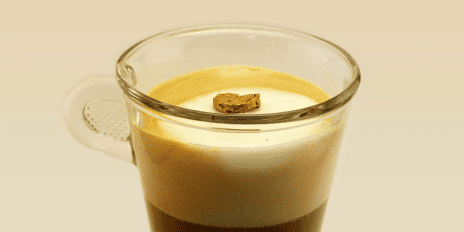Imagine a nugget of real, 20 carat gold floating merrily on the milk foam of your cup of warm cappuccino — scientists from ETH Zurich have found a way to do it. It’s not super-cappuccino, or diamond-strong foam — scientists led by Raffaele Mezzenga, Professor of Food and Soft Materials at ETH have produced a novel foam of gold, a three-dimensional material that is actually mostly…empty.

Image via ethz
“The so-called aerogel is a thousand times lighter than conventional gold alloys. It is lighter than water and almost as light as air,” says Mezzenga.
To the naked eye it looks just like a sturdy, shiny block of conventional gold, but that’s where the resemblance ends — this foamy gold (that’s what I’m calling it) is soft and malleable by hand. It’s 98 percent air held together loosely by gold (four-fifths of the solid material) and milk protein fibrils (one-fifth), qualifying it as 20 carat gold.
The material is created by first heating milk proteins until they coalesce into nanometre-fine fibres named amyloid fibrils. The fibrils are placed in a solution of gold salt, where they interlace into a basic structure that the gold crystallizes on in small particles. The end result is a gel-like gold fibre network.
“One of the big challenges was how to dry this fine network without destroying it,” explains Gustav Nyström, postdoc in Mezzenga’s group and first author of the study.
Air drying wasn’t viable as it could damage the gold structure, so the scientists opted for a gentler but more laborious process that relies on carbon dioxide, assisted by the Professor of Process Engineering Marco Mazzotti.
This method of production, where the metal particles crystallize during the manufacture of the protein scaffold rather than after its completion, is novel. And one of its biggest advantages is that it makes it easy to create a homogeneous gold aerogel that mimics gold alloys perfectly.
It also allows scientists numerous possibilities to influence the properties of the material.
“The optical properties of gold depend strongly on the size and shape of the gold particles,” says Nyström. “Therefore we can even change the colour of the material. When we change the reaction conditions in order that the gold doesn’t crystallise into microparticles but rather smaller nanoparticles, it results in a dark-red gold.”

Image via ethz
The new material could be used in many of the applications where gold is currently being used, says Mezzenga. The substance’s properties, including its lighter weight, smaller material requirement and porous structure, have their advantages. Applications in watches and jewellery are only one possibility.
Another use demonstrated by the scientists is chemical catalysis: since the highly porous material has a huge surface, chemical reactions that depend on the presence of gold can be run in a very efficient manner. The material could also be used in applications where light is absorbed or reflected. Finally, the scientists have also shown how it becomes possible to manufacture pressure sensors with it.
“At normal atmospheric pressure the individual gold particles in the material do not touch, and the gold aerogel does not conduct electricity,” explains Mezzenga. “But when the pressure is increased, the material gets compressed and the particles begin to touch, making the material conductive.”






